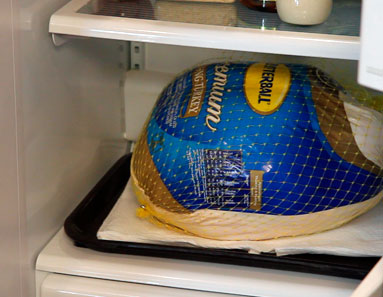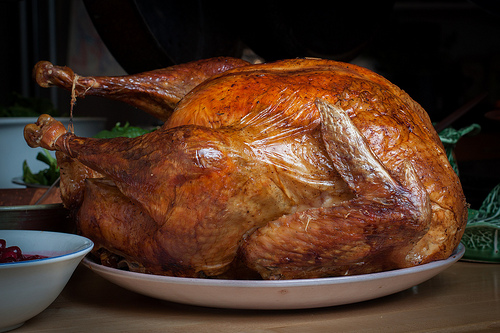It’s hard to imagine Thanksgiving without a big, beautiful, juicy turkey. Stumped on how to pull that off? Here are the basics on how to have a beautiful, delicious Thanksgiving turkey.
What to buy: fresh or frozen turkey?
There’s not much difference between a fresh or frozen turkey. Fresh is more convenient if you’re pushed for time, but will cost more per pound than frozen. Fresh turkeys may occasionally have ice crystals (from being refrigerated and transported at very cold temperatures) that will need to thaw.
When selecting a turkey:
- Keep in mind that two smaller turkeys may serve your needs better than one large. A general rule of thumb for figuring what size turkey you’ll need is to buy a pound of turkey per person, allowing for bones, skin, fat, etc.
- When choosing a turkey, look for packaging that is intact with no holes or tears.
- Choose your turkey last on your shopping trip to prevent having a thawing turkey in your cart to contaminate your other grocery items.

How to thaw a frozen turkey
It’s best to thaw turkey in the refrigerator, where it’s too cold for harmful bacteria to grow. Use the bottom shelf, in case of drips. Place the turkey breast side up in its original wrapper on a rimmed baking sheet. Plan ahead to allow a full day for every 4 pounds of turkey being thawed.
To thaw the bird in less time, place the turkey in its unopened bag in a large container, and cover it with cold water. Change the water every 30 minutes to keep it cold (and safe). This will thaw an 8-12 pound turkey in four to six hours, while a 12-16 pound turkey takes six to nine hours.
Safety tips for thawing turkeys
- Place thawing turkey in a leak proof plastic bag. A new (unscented) kitchen garbage bag works well. This keeps juices from the thawing turkey from contaminating your kitchen and refrigerator. (Double bag as an added precaution.)
- Plan ahead for thawing your turkey: a 24-pound turkey can take up to six days to thaw in the refrigerator.
- Clean as you go when handling turkey. Wash hands and utensils with warm, soapy water and wash counters with a bleach cleaning solution.
- Have your pans, seasonings and equipment ready to go before removing your thawed turkey from the refrigerator.
How to prepare a turkey for cooking
When you bring a fresh turkey home or thaw out a frozen one:
- When the turkey is completely thawed, remove the giblets and the neck from the body cavity (usually in a sack inside the bird).
- Rinse inside and out with cold water.
- Truss the turkey so it will cook evenly, retain moisture and have a compact shape. Here’s how.
Step 1: Secure the legs. Some turkeys come with a metal clip. If yours doesn’t, use cotton twine (ask your butcher for some).
Step 2: Tuck excess skin down between the breast and the legs, so the skin won’t split as the turkey cooks.
Step 3: Lift the tips of the wings up and over the breast, and tuck them under the turkey; secure excess of the neck flap (use a wooden pick if necessary).
Step 4: Line the bottom of the roasting pan with foil for easier cleanup. - Place the turkey on a rack in a shallow roasting pan. If you don’t have a roasting pan, use a large foil roasting pan from the supermarket, and place it on a baking sheet for extra support.

Roasting turkey 101
- Don’t seal turkey with foil or a roaster lid, because it will steam rather than roast. If you choose to use an oven cooking bag, follow instructions on the box for moist, succulentturkey.
- Coat turkey with butter or oil to add flavor and help with browning.
- Rub turkey skin with salt, pepper, and herbs and spices. Sage, garlic or garlic powder, onion or onion powder, rosemary and thyme are great choices. You can also buy a poultry seasoning mix in the spice section of the grocery store.
- Fill the cavity with a half a stick of butter, an onion cut into wedges, and sprigs of fresh parsley, rosemary and/or thyme.
- Place a meat thermometer in the thickest part of the thigh (being sure not to touch the bone). The turkey is done when the thermometer registers 180° F. Breast meat, which has less fat, only needs to come to 170°F. It also applies if you’re doing a turkey breast rather than a whole turkey. You can estimate cooking time for an unstuffed turkey at 325 degrees will be approximately 15 minutes per pound.
- If you’re more impressed with moist, juicy turkey than a picture-perfect one, cook the turkey breast-side down. The juices will run down into the breast, making it moist.
- Add a cup of water to the bottom of the pan before putting into the oven.
- About every 30 minutes, use a turkey baster to drizzle the juices from the pan over the turkey as it cooks.
- Allow turkey to stand 15 to 20 minutes before carving.
There are two ways to get that perfectly browned turkey:
- Cook the turkey UNCOVERED until it is browned then cover and cook until done.
- Cook the turkey COVERED for one-and-a-half hours and then remove it to finish cooking and browning.
If stuffing the turkey, do so just before roasting to prevent unwanted bacterial growth. Because the stuffing will expand as it bakes, fill the turkey’s cavity loosely. This also allows the stuffing to cook more evenly and keeps it from becoming too dense. A 12-15 pound turkey needs about 10 cups of stuffing. A 15-20 pound bird can hold up to 12 cups. To test doneness before serving, insert an instant-read thermometer in the center of the stuffing to make sure it reaches 165 degrees.
How to store turkey leftovers
Don’t tie up valuable space in the refrigerator with the turkey carcass. Remove the meat from the bones. Place white meat slices and dark meat pieces in separate zip-top plastic bags, ready for sandwiches or other recipes.
Leftovers can serve as the main ingredients for dishes you might not otherwise make. Sliced turkey can become the main ingredient in an open-faced sandwich, a turkey spinach salad, or a turkey-salad sandwich. Even the turkey bones can have a second life. Use them as the basis of a delicious turkey stock, which can be frozen for up to four months and used in any recipe calling for chicken stock.
Happy Thanksgiving from Arkansas Farm Bureau’s Taste Arkansas.
